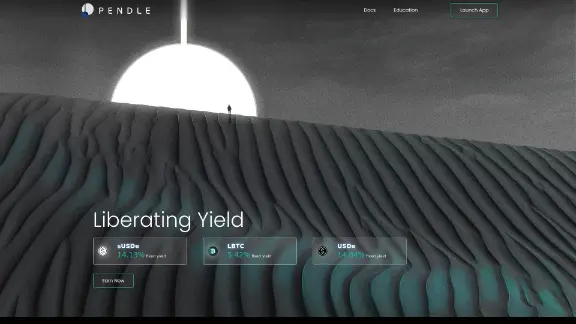Pendle (PENDLE)
Pendle Finance is a decentralized finance (DeFi) protocol that enables users to tokenize and sell future yields. This system allows users to generate additional yield and secure future yield upfront, while traders gain direct exposure to future yield streams without needing underlying collateral.
Overview
Pendle Finance was established in October 2020. It provides a platform where users can separate future yield from their base yield-bearing assets. By utilizing renowned DeFi protocols such as Aave and Compound, Pendle facilitates the tokenization and trading of future yields. The protocol is powered by an automated market maker (AMM) specifically designed to support tokens with a decreasing time value, creating a new type of DeFi derivative. Pendle aims to leverage the volatility of yield to offer more options for yield management based on individual risk preferences, thereby enhancing the DeFi trading landscape.
In August 2023, Pendle introduced its first real-world asset (RWA) centered offering, incorporating MakerDao's enhanced Savings (sDAI) and Flux Finance's fUSDC. Tokenizing RWAs connects digital investment systems to physical assets like real estate and collectibles.

| Ticker | PENDLE |
| Category | Decentralized Exchange (DEX) |
| Website | https://pendle.finance/ |
| @pendle_fi | |
| Telegram | pendlefinance |
| Contract Addresses | |
|---|---|
| ethereum | 0x80...27 Copied! Copied! |
| base | 0xa9...3e Copied! Copied! |
| optimistic-ethereum | 0xbc...e1 Copied! Copied! |
| binance-smart-chain | 0xb3...07 Copied! Copied! |
| arbitrum-one | 0x0c...e8 Copied! Copied! |
Tech
Pendle incentivizes the pooling of yield-generating assets and the creation of yield markets across DeFi platforms. Holders of these assets can sell their rights to yield for a fixed period, receiving upfront cash. When users deposit tokens into Pendle, they mint two types of tokens: an Ownership Token (OT), representing the underlying principle, and a Yield Token (YT), representing the right to receive yield. Users can deposit their YT into Pendle's AMMs for liquidity provision or sell their YT for immediate cash.
Yield tokenization
Yield tokenization involves depositing a yield token into a smart contract, resulting in the issuance of two tokens: XYT and OT.
Future Yield Token (XYT)
Each XYT token represents ownership of future yield for a predetermined number of blocks. These tokens can be traded, and holders receive yield as distributed by the base lending platform. XYT tokens vary based on the underlying asset and expiry date, but tokens with the same asset and expiry are fungible.
Ownership Token (OT)
OT tokens represent the underlying staked asset and are transferable. Only wallets holding both OT and its corresponding YT can withdraw the deposited asset.
Pendle V2
Pendle V2 introduces an AMM that minimizes time-dependent impermanent loss, enhancing liquidity provision, capital efficiency, and flexibility. Key features include minimal impermanent loss, improved capital efficiency, low-slippage trades, and optimized liquidity ranges. V2 AMM is optimized for trading fixed rates with Principal Tokens (PT) and supports standardized yield tokens. The vePENDLE mechanism aligns incentives, generating liquidity and fees, and promoting high fee-earning pools.
Tokenomics
Pendle's PENDLE token was launched in April 2021 as an ERC-20 token on the Ethereum blockchain, initially serving as a utility token with future governance functions. The maximum supply is 251 million, with allocations for the team, ecosystem, and other stakeholders. In July 2023, PENDLE tokens became available for farming on Binance Launchpool.
Token allocation
- Team: 22%
- Investors: 15%
- Advisors: 1%
- Liquidity Bootstrapping: 7%
- Liquidity Incentives: 37%
- Ecosystem Fund: 18%
Vesting schedule
Investors and team members follow a vesting schedule to align incentives:
- Team: 2-year vest with a 1-year cliff, followed by quarterly release
- Investors & Advisors: 1-year vest with quarterly release starting 3 months after LDB
- Ecosystem Fund: 50% no vest, 50% unlocked after 1 year
Fees
Pendle charges two types of fees:
- Forge Fees: 3% of the interest accrued from YT goes to the Pendle Treasury.
- Swap Fees: 1% on trades, with 0.85% to LPs and 0.15% to the Treasury.
Pendle $APE Compounder
Pendle launched the ApeCoin ($APE) market, allowing users to buy $APE at a discount, provide liquidity, and boost pool incentives with vePENDLE. The Pendle $APE Compounder facilitates easy staking and compounding without fees, significantly enhancing $APE's earning potential.
Governance
Pendle's governance operates through vePENDLE, allowing token holders to access features enhancing the token's utility and stability. vePENDLE holders can vote on liquidity incentives and receive swap fees and protocol revenue.
Penpie
Penpie is a DeFi platform integrated with Pendle Finance, focusing on locking PENDLE tokens for governance rights and yield benefits. Penpie offers mPENDLE, allowing users to convert their tokens for enhanced APR. It also integrates with Layer Zero for cross-blockchain interoperability.
PENDLE unlock
The minimum lock duration is 1 week, and the maximum is 2 years. Users can adjust the lock duration or add more PENDLE, with the unlock date adjusting accordingly.
Fundraising
Pendle Finance raised $3.7M in April 2021, led by Mechanism Capital with support from various investors. In August 2023, Binance Labs invested in Pendle Finance to support its expansion across blockchain networks. In November 2023, Spartan Capital made an additional investment, highlighting Pendle's significant growth and potential to attract off-chain capital.
